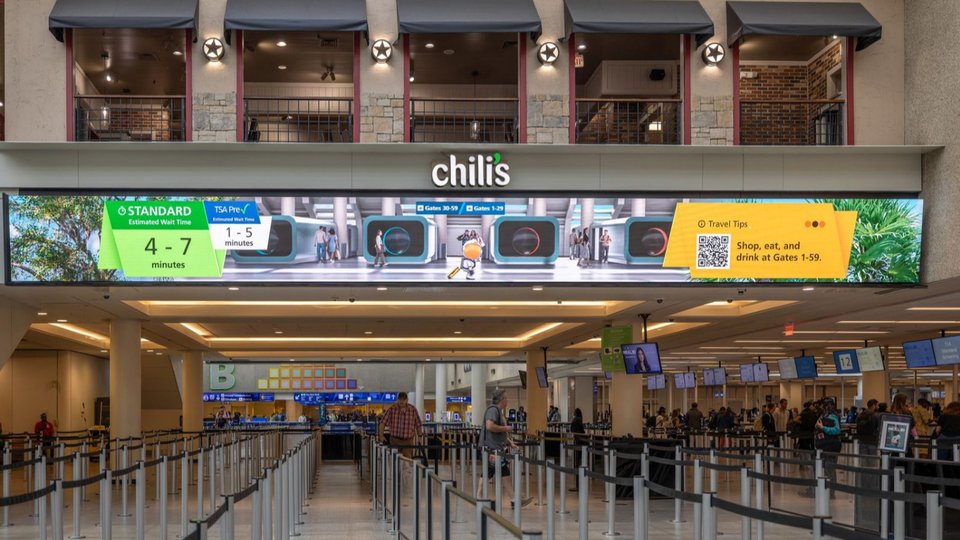Display Technology
Orlando airport’s digital ‘Annie’ elevating passenger experience, driving efficiency
Travelers arriving or departing Orlando International Airport likely already know ‘Annie’ but the animated astronaut is now making the checkpoint environment in Terminals A and B faster, calmer and more fun.

October 31, 2025 by Judy Mottl — Editor, RetailCustomerExperience.com & DigitalSignageToday.com
Few people would disagree that airport travel can be one of the most stressful and least enjoyable customer experiences.
From checking in at the counter to trudging through the security checkpoint the traveling experience is often a landmine of frustrations.
But the Greater Orlando Aviation Authority (GOAA) at Orlando International Airport (MCO) in Orlando, Florida has changed that scenario with communication displays and a very friendly and fun animated companion.
Meet Annie the Astronaut
Travelers familiar with MCO have met the airport's friendliest ambassador — an animated digital display presence called Annie the Astronaut.
Annie is powered by Synect's Passenger360 digital content management system, which runs more than 2,100 digital displays across MCO's Terminals A, B, and C and the train station.
Annie's role has now expanded beyond digital displays and she stars in massive LED video walls at the airport's Security Checkpoint for Gates 1–59, a high volume touch point.
Airport leaders recognized how Annie could make the security experience, as well as customer experience, less stressful and more enjoyable.
The animated astronaut's 3D journey includes terminal scenes, over 100 original characters and thousands of frames of high-end animation. Created by Orlando-based agency Synect, the experience blends storytelling with smart design, offering a welcome distraction for families, first-time flyers and anyone with travel anxiety. Annie offers up helpful information while strolling through a 3D replica of Terminals A and B, complete with check-in counters, plants, a food court and other elements modeled directly from the facility.
The content shares real-time TSA wait times, 3-1-1 reminders, divestment tips such as bin reminders, post-security concession highlights via QR code and themed "Easter Eggs" like a digital version of MCO's much-loved carpet.
"Checkpoint environments can be stressful, so we wanted to bring in the friendly, engaging, and informative element she provides to help guide passengers through the process," Karla Carman, senior manager, wayfinding and signage program at MCO, said in an email interview.
Annie's "journey" mirrors the actual passenger flow through Terminals A and B.
"The experience includes divestment instructions, access to airport amenities and more. The goal was to make the process faster, calmer, and more enjoyable, while also showcasing what's waiting for passengers after security," said Carman.
Annie's Journey's is a robust digital experience when it comes to content. Features include:
- Eight custom scenes based on MCO's terminal architecture.
- Over 1,000 animated elements and 100-plus custom character models.
- More than 7,200 rendered frames built in Maya, Cinema 4D and After Effects.
- Live API integrations for real-time updates.
- Airport-specific details, including native Florida trees, MCO's iconic carpet and Synect's ReadySeeGo devices.
How Annie's journey came together
Synect began working with the GOAA in 2015. The first project was a seven-screen pilot for a check-in video wall and additional wayfinding. The project's success led to a custom content strategy co-developed with GOAA and a phased rollout of Synect's Passenger360 digital content management system.
"The Annie's Journey experience is part of a much larger visual communication strategy that MCO has built with Synect over 10 years. We have always looked for ways to make our airport more efficient, easier to navigate, and more enjoyable for passengers, and we've found that large-scale, thoughtfully designed digital experiences are a powerful tool for achieving that," said Carman.
"Annie the Astronaut has been part of that journey for years, so bringing her back to the Security Checkpoint for Gates 1–59, because she's been here before in different capacities, was the right choice for this new security experience," added Carman.
The focus, from the start, has been an airport-wide visual communication program and platform that enhances passenger experience while streamlining operations, according to Yahav Ran, Synect CEO.
"Together with GOAA, we create custom content and experiences such as airport and airline branding, wayfinding, flight information, helpful information, multilingual content and more. The content strategy and system ensure passengers get the right information when and where they need it," Ran said in an email interview.
Synect began developing Annie the Astronaut with MCO in 2016.
"Annie has appeared on a range of digital signs for years, recently became the namesake and face of Annie's Space Sensory Room and her journey on the Security Checkpoint for Gates 1–59 video wall is her latest adventure. Annie was the first digital ambassador we created for an airport; she's since been joined by Annie's dog, later named Luna by MCO travelers and fans," said Ran.
Conceptual design for Annie the Astronaut's Journey began in November 2024 and the experience launched in June 2025.
"In terms of duration, creative scope, and the number of 3D models, scenes and characters created, Annie's Journey ranks as one of Synect's largest creative content projects to date," said Ran.
Challenges in crafting Annie's journey
While the 'journey' development has proved rewarding the project wasn't without hurdles, according to Ran.
"Our recent Annie's Journey project presented numerous fun and unique challenges, thanks to its ambitious vision and robust 3D approach," he said, adding Synect's studio recreated eight distinct airport scenes, complete with characters, props and architectural details based on MCO's real-world Terminals A and B.
"Even MCO's iconic carpet, beloved by travelers, was faithfully recreated in digital form, with plenty of pressure to get it right," he said.
Carman calls Annie's Journey one of the airport's most ambitious creative projects.
"Coordinating input from multiple airport departments, stakeholders, and our creative and technology teams at Synect required careful planning and a strong shared vision," she said, adding "balancing the operational requirements of the checkpoint with the artistic and technical demands of a large-scale 3D animation was no small task. Still, the collaboration between all stakeholders was key to overcoming those challenges."
Before Annie's Journey came into play the terminals boasted a digital fish tank experience. The projected transformation set the creative bar high.
"We held multiple blue-sky ideation sessions with GOAA, generating a range of concepts," said Ran. "As always, our shared approach to digital content blends useful information, high impact engaging visuals and subtle nudges to aid passengers and guide them toward a desired outcome."
A digital journey through the airport quickly emerged as the front-runner design with Annie as the traveler and guide.
"The experience combines real-time TSA wait times, divestment tips to help passengers prepare for screening, and post-security concessions information via an integrated QR code. This mix makes wait times feel shorter, keeps the checkpoint environment calmer and more efficient and encourages passengers to explore MCO's many amenities after security," said Ran.
Why digital display is taking flight
Digital and display technology, within an airport environment, is taking deeper root for a wide range of reasons — travelers are more tech savvy and holding ultra-high definition devices in hands and homes.
"Traditional airport signage often feels outdated by comparison and can even add to passenger stress when clarity and simplicity are what they need most," said Ran, adding "emotions run high during travel, and passengers' needs shift throughout the journey, making clear, engaging communication critical."
Another factor driving digital tech at airports is consumer expectation — travelers are seeing experiences not just a way to move from one place to another.
"Forward-looking airports like MCO are positioning themselves as destinations, offering visitor passes to encourage the public to explore terminals, amenities, and retail," said Ran. "Modern passengers want polished, shareable moments, and large-scale digital video walls with beautiful, dynamic content offer an eye-catching way to both inform and brand an airport."
Airport and flight competition is also driving greater adoption of experiential digital tech.
"They must meet passenger needs, manage the movement of thousands of travelers daily, support airlines, advertisers, concessionaires and TSA, represent their communities, comply with evolving regulations and plan for future growth," said Ran.
Innovative digital experiences, paired with the right content, solutions, and infrastructure, can help achieve all these goals, he said.
Carman said the airport will continue to explore ways to feature Annie the Astronaut in new campaigns and touch points.
"From wayfinding to our new sensory rooms, she's become an adaptable ambassador for MCO's brand and passenger experience," said Carman.
Tips, advice for tech experiences in airports
Airports looking to deploy similar content and digital-driven experience should start by understanding how the experience will fit into the airport's overall passenger journey.
"For us, Annie's Journey wasn't just about adding something eye-catching to the checkpoint; it was about easing a potentially stressful process, improving passenger flow and operations, and giving passengers a delightful memory of their time at the airport," said Carman.
From there, Carman recommends involving all relevant stakeholders early.
"This may include operations, security, customer experience, and others, so the end product serves everyone's needs. And finally, think about scalability from day one. If the experience is successful, you'll want the flexibility to expand it across other areas of the airport without starting from scratch," she said.
Ran said the starting point is strategy, not screens or technical decisions or investments.
He recommends starting with these five core questions:
- What are the passengers' needs? What problem are we solving or benefit are we providing?
- What are the stakeholders' needs? What must airport teams communicate, and what functionality is required?
- What about the physical environment? How do we reach passengers at the right moments?
- What is our content strategy? How do we communicate across the airport effectively?
- Where is the gap? What do we need to invest in to execute the plan?
"This enables airports to right-size their technology investment and ensure their software can deliver on the airport's ultimate vision and goals," he said. "We recommend investing in an approach and system purpose-built for airports and designed to adapt to hyper-dynamic environments and unique workflows. We also advise working with a partner who can deliver both the software and the content. This alignment cuts costs, improves efficiency, and ensures a seamless passenger experience."







